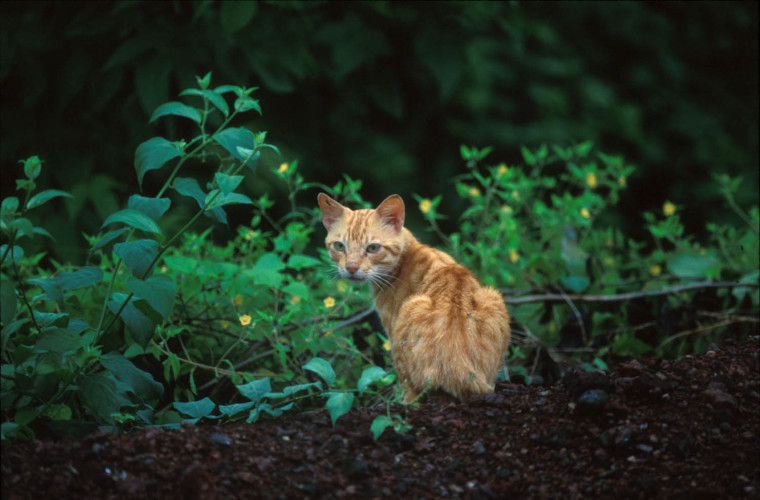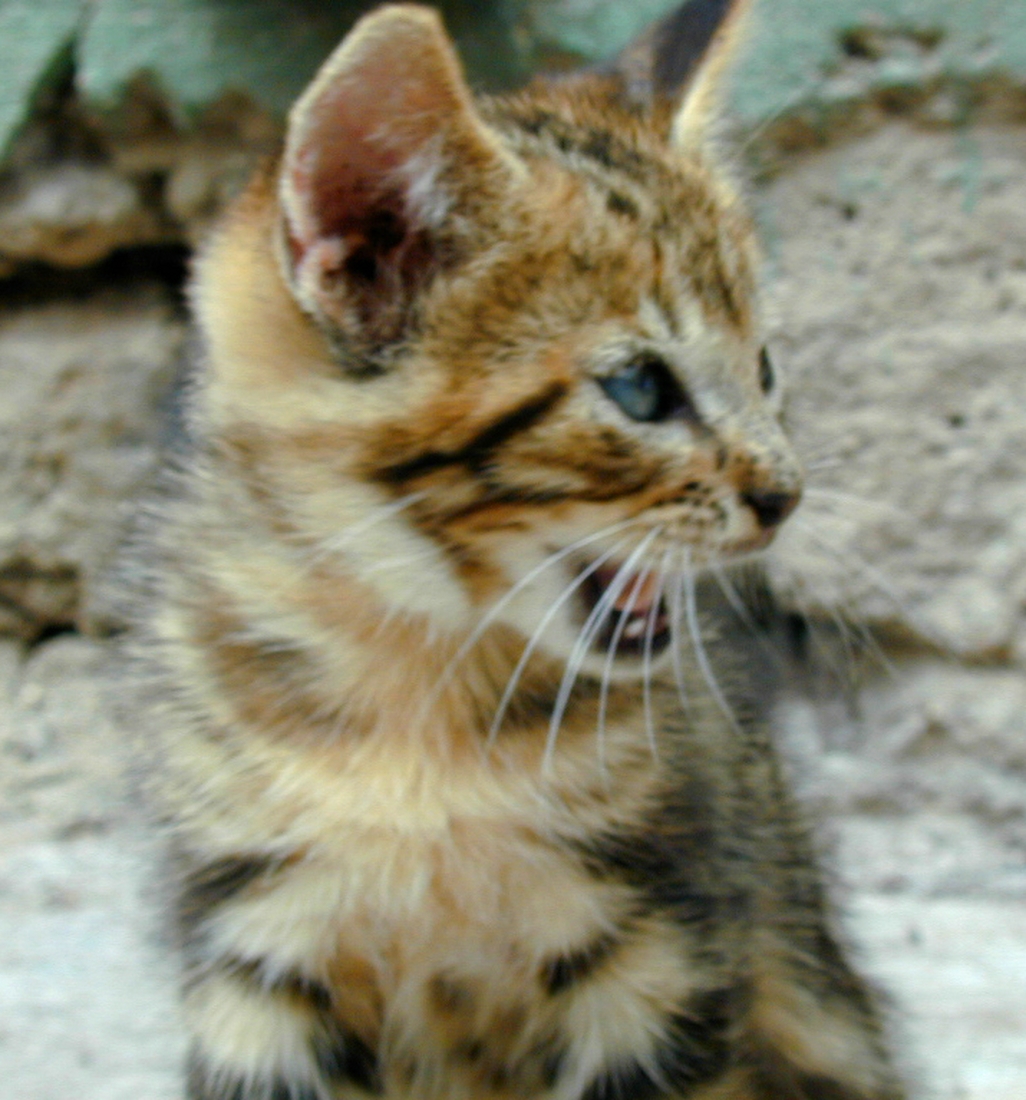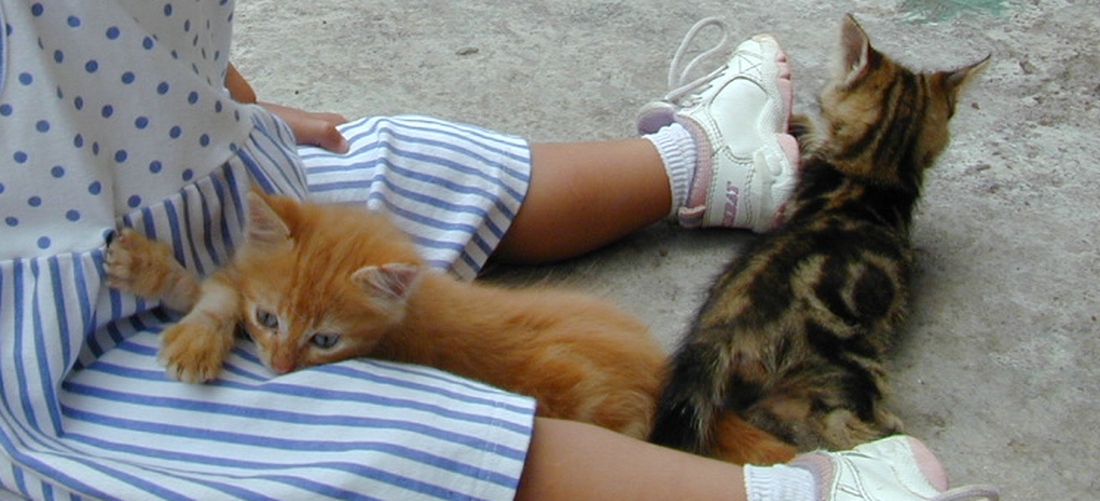Galapagos Species Database
The Galapagos Species Database shares the information about the species from our Natural History Collections.
Felis catus
Gato doméstico introducido, Felino, Gato doméstico, Cat




The domestic cat is a carnivorous mammal in the Felidae family. They are predators by nature that often hunt at night and prey on numerous species of small mammals, birds, reptiles, amphibians, fish, and invertebrates. They have a soft, wooly fur with a shiny appearance that they maintain by frequent grooming. Their body is flexible, light, muscular and compact with around head and short ears. Their forelimbs usually have five digits and hind legs have four with naked digital pads that allow them to stalk prey quietly. Their claws are retractable, long, sharp, curvy and laterally compressed. The eye pupils contract vertically, they have a secondary eyelid or nictitating membrane to protect the eye. Their tongue is adapted to lacerate and detain food with the surface covered by curvy point papillae. Their teeth clearly reflect their predtor nature. They have a very good sight and hearing. They have glands in the head and tail which they use to mark their territory. Females possess four pairs of mammae. Even when kept as pets, cats live in a semi-wild status (feral) and are among the IUCN 100 worst invasive species.
Domain
Eukaryota
Kingdom
Animalia
Phylum
Chordata
Class
Mammalia
Order
Carnivora
Family
Felidae
Genus
Felis
Species
catus
Taxon category: Accepted
Synonyms: Felis catus domestica, Erxleben 1777 and Felis sylvestris Schreber 1777. There is some confusion as to the correct species name. Schreber (1775) illustrated a plate as 'Felis Catus ferus', and in 1777 the text listed 'Felis (Catus) silvestris' and 'Felis Catus (domestica).' Opinion 465 of the International Commission on Zoological Nomenclature (1957f) declared silvestris as the specific name for the European wild cat (with the understanding that F. catus and F. silvestris are usually considered conspecific). Wilson & Reeder (eds., 2005) note that some consider catus and sylvestris (and lybica/libyca) to be conspecific. If this view were followed, there would be a problem with the continued use of the name Felis sylvestri.
Taxon origin: Introduced - established
Preference for an altitude zone in Galapagos: Coastal zone - high altitude dry zone
Habitat preferences: In Galapagos cats have been observed in coastal areas, agricultural areas, wet areas, wetlands, altered areas, natural forests, swamps, riparian areas, dry forests and shrubs, urban areas, and even on volcano summits (1707 meters over sea level, Wolf Volcano, Isabela island – highest elevation in Galapagos islands). Cats are easily adapted to extreme climates withstanding high temperatures and cold temperatures. The only requirements for these animals are water, food and shelter.
Feeding preferences: They prefer to feed on fresh meat harvested by them. Cats have been seen hunting land and marine iguanas and juvenile tortoises and turtles, land and sea birds, lizards, geckos, snakes and terrestrial invertebrates in Galápagos.
Trophic role: Carnivorous
Persistence mechanisms: Cats are intelligent animals capable of learning based on experience or observed experiences of their peers. Their sense of smell, hearing, and touch are highly developed making them successful hunters with the ability to survive in many habitats.
Reproduction mode: Exclusively sexual
Reproductive biology: Sexual maturity is reached at 4-5 months for females 6-7 months for males. Gestation lasts 65-67 days with a litter size is 1-10 kittens. Females have several periods or estrus each year that last 4-7 days during which they can copulate with multiple males leading to litters of mixed paternity.
Distribution origin: Se creía originario de África, pero evidencias genéticas recientes lo señalan procedente de Medio Oriente.
Natural enemies: Most medium sized or larger reptilian, mammalian, or avian predator will take cats. In Galapagos, cats do not have any natural enemies except introduced dogs and perhaps hawks, but these have little effect on their population size.
Associated species in Galapagos: Humans
Economic Use: The only economic value cats have is based on the sale of these animals when they are pure breed. They can be as expensive as hundreds or thousands US dollars.
Mode of introduction: Intentional
Introduction Pathway: Intentional
Subpathway: Pet/aquarium/terrarium species
Introduced status: Naturalized
Invasive status: Unlikely to become invasive
Impact in Galapagos: Cats have serious impact on wildlife in the Galapagos due to high population numbers in populated areas and nearby park lands in the Galapagos.
Impact elsewhere: Elsewhere in the world, particularly on islands, cats have been the culprits in the extinction of a large number of seabirds, song birds, amphibians, reptiles, small mammals and even invertebrates. Feral cats have been reported in Jamaica, Fiji, New Zealand, Austrlia, Mexico, Greece, Spain, France, Hawaii, etc. On Little Barrier Island in New Zealand, cats were responsible for the extinction of seven bird species. Birds are the most affected vertebrates by cats. Cats can also carry a variety of pathogens and diseases, some of which can be transferred to humans.
Control History in Galapagos: The Galapagos National Park controls cats in protected areas and the Galapagos Biosecurity Agency manages them in urban areas. Since 1980 the GNP has developed poisoning campaigns in critical areas such as breeding grounds for land iguanas, penguins, cormorants, andsea turtles. However, these efforts have had limited success and cats continue to be a problem. Cats have been successfully eradicated from Cartago Bay on Isabela Island where they conduct three poisoning campaigns per year as opposed to elsewhere where control efforts are limited to a single treatment per year. Cats were not detected during monitoring efforts at Cartago Bay in 2011-2013 and this has resulted in increased recruitment of land iguanas (Conolophus subcristatus) at this site. The GBA has sterilization campaigns for domestic cats have not been successful as many pet owners are unwilling to collaborate with this program. The GBA also captures and euthanizes street animals. Regulations ban the importation and interisland transport.
Control methods elsewhere: The eradication and control of feral cats has been very difficult and expensive. In New Zealand, they have been eradicated from three small islands. As in some other places in the world, they have used a combination of different methods that include hunting, trapping and bait poisoning. Trapping and bait poisoning seem to be the most efficient method to control wild cats. The sterilization of cats kept as pets is important but this requires the collaboration of pet owners which is often difficult to obtain.
Known Pest elsewhere: Widespread throughout the world, principally on islands.
Prevention options: Use of poison baits and by direct removal by firearms and trapping. It is necessary variety of methods to eradicate them. In the Galapagos all cats should be sterilized and importation prevented.
Year of first record: 1832
Year of introduction: 1832
Map of specimen collection localities or observation records for this species in our collections database.
Distribution: They are widely distributed in Floreana, Santa Cruz, Isabela and San Cristobal, where they are feral and as pets in populated areas. They were eradicated from Baltra Island in 2004.
- Jiménez-Uzcátegui, G. Carrión, V., Zabala, J., Buitrón, P. & Milstead, B. (2007) Status of introduced vertebrates in Galapagos. Galapagos Report 2006–2007. Charles Darwin Foundation, Puerto Ayora, p. 136–141.
- Salvin, O. (1876) On the avifauna of the Galápagos Archipelago. Transactions of the Zoological Society of London 9: 447-510.
- Naveda, B. (1949) Galápagos a la vista. Ediciones Últimas Noticias, Quito, Ecuador.
- Jácome, M. (1989) Mamíferos introducidos en Galápagos. Informe técnico para la Fundación Charles Darwin y Servicio Parque Nacional. Galápagos. Puerto Ayora, Ecuador. 33 pp.
- Levy, J.K. Crawford, C., Lappin, M.R., Dubovi, E.J,. Levy, M.G., Alleman, R., Tucker, S.J. & Clifford, E.L. (2008) Infectious diseases of dogs and cats on Isabela island, Galapagos. Journal of Veterinary Internal Medicine 22: 60-65.
- MacDonald, I. A. W. (1987) Estrategias para limitar la invasión de organismos introducidos a las áreas protegidas Memorias. Investigación Botánica y Manejo en Galápagos. Pg.210-223
- Balseca, M.A (2002) Respuesta de la lagartija de lava (Microlophus albermalensis) a la erradicacion de gatos ferales (Felis catus) en la isla Baltra, Galápagos. Tesis, Universidad del Azuay. Tesis, Universidad del Azuay.
- Borroto-Paez, R. et.al. (2013) Valoración rápida de gatos ferales y otros mamíferos invasores en cayo Santa María, norte de Villa Clara, Cuba. Solenodon 11. Pp 120-130.
- Brickner, I. (2003) The impact of domestic cat (Felis catus) on wildlife welfare and conservation: a literature review. Web: http://www.tau.ac.il/lifesci/zoology/members/yom-tov/inbal/cats.pdf
- Dexter, N Dowler, C., Flanagan, J.P., Hart, S., Revelez, M.A. & Lee, T.E. (2004) The influence of feral cats Felis catus on the distribution an abundance of introduced an endemic Galápagos rodents. Pacific Conservation Biology. Volume 10, Number 4. Pp. 209- 215.


Feeding type: Polyphagous
They are predators with nocturnal hunting habits that feed on many species of small vertebrates and invertebrates. When domesticated they are omnivorous but feral cats are strictly carnivorous though they may consume small amounts of plant matter to stimulate a regurgitation reflex that helps to expel indigestible material such as hair balls and prey bones.